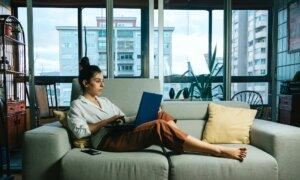Work-from-home arrangements—one of the “legacies” of the pandemic—has seen a large number of working adults “stressed and sedentary,” as individuals, employers, and policymakers navigate their way around the impacts of this work setting in the post-pandemic world.
Conversely, one in three Aussies reported higher levels of physical activity from the new work arrangement, which may be an attempt to offset the higher levels of sitting. While higher levels of physical activity may be somewhat moderating, anxiety and stress have increased—a possible reflection of the ongoing pandemic.
These findings stem from a survey conducted with 1,165 Sydney residents between October and December 2020, after the first restrictions from the initial COVID-19 wave were significantly reduced nationwide.
Work From Home Exacerbated Known Risks
The authors noted that work-from-home arrangements exacerbated known risks of ill-equipped home-working environments, such as trip hazards, psychosocial impacts such as isolation and blurring of work-family boundaries, and unhealthy behaviours such as diet, sleep, and addiction.“This also amplified aforementioned concerns around work-related sedentary behaviour, with employees reporting longer times sitting at their desks and less overall physical activity in the absence of commuting and work-related travel—accentuated by increasing use of virtual meetings,” the authors wrote.
Work From Home Arrangements and Exercise
Just over half of those surveyed reported more work-from-home days compared to before the pandemic.A proportion reported an increase in active travel for non-work purposes, with 37 percent increasing their walking activities and 15 percent cycling.
In addition, 36 percent reported increases in walking or cycling for leisure, and walking or cycling for exercise (31 percent).
However, 43 percent reported more anxiety or depression, and almost two-thirds were more concerned about the future.
Three cluster groups were categorised by the authors: active but anxious (22 percent), less change less worry (38 percent), and stressed and sedentary (40 percent).
The first group, “active but anxious” reported the lowest relative levels of active commuting, and the second highest relative levels of sitting and stress, but, had the highest relative levels of physical activity. This group was slightly younger and had higher household incomes.
The second group, “less change, less worry” reported the least relative change in levels of physical activity and active commuting, and the lowest relative levels of stress. The group was predominantly male and had seemingly limited impacts on their work and physical activity.
Consequences of Insufficient Physical Activity
Insufficient levels of physical activity, such as sitting for long periods of time, contribute to chronic diseases, such as type 2 diabetes and cardiovascular diseases, higher mortality, as well as higher levels of depression and anxiety.“During the pandemic, reported levels of physical activity generally declined in Australia and many other countries, although, as we found in our analysis, there was significant heterogeneity across the population,” the authors wrote.
“As the need to travel to work and move during the day to attend meetings, etc. has been replaced by a laptop on the kitchen table and virtual meetings, people are invariably sitting more.
Recommendations
According to the authors, the research highlights the importance of promoting physical activity and reducing sedentary behavior to improve overall well-being, especially in the context of working from home.By knowing which groups are most stressed or sedentary, policymakers can shape legislation in a way that guides employers and employees on physical activity and work-from-home arrangements.
Under the Work Health and Safety Act 2011, employers are required to provide a workplace designed to eliminate or minimise health and safety risks.
The authors argue that the legislation and guidelines need updating to provide more explicit guidance about the need for regular interruptions to sitting and encourage more physical activity.
“In the absence of legislation, responses by employers have been largely ad hoc, and there is still much work required to ensure that workers have appropriate support and workplace health and safety protections.”
“However, an engaged employer should be proactive in addressing the issue, encouraging healthier work practices, and perhaps more radically exploring mechanisms to incentivise healthier behaviours to tackle the growing financial costs of physical inactivity.”
Apart from sitting strategies—such as placing the screen at eye level, supporting the back with lumbar support, keeping the knees at the level of the hips, and positioning the keyboard so that the wrist and forearms are straight and the elbows to the side of the body form an L-shape, keeping both feet on the floor—workers should also take regular breaks every hour to stretch their legs, drink water, and do some neck and back stretches.







